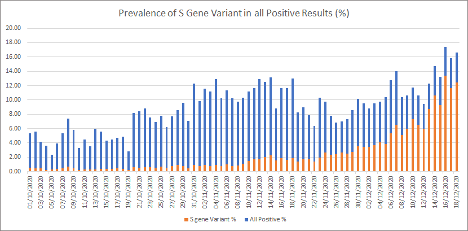Should business leaders be worried about the new COVID strains originating in the UK, South Africa, Brazil, and elsewhere — and recently identified in the US?
The authorities have focused on downplaying concerns about vaccine effectiveness against these new variants. While some legitimate concerns exist that our vaccines might be 10-20% less effective against the new strains, this small difference shouldn’t make you too worried.
However, another aspect of these new variants should make you very worried indeed: they’re much more infectious. Unfortunately, the implications of their infectiousness have received little news coverage.
In fact, some officials claim there’s no cause for alarm about the new strains. Such complacency reflects our sleepwalking in the pandemic’s early stages, despite numerous warnings from myself and other risk management experts, leading us to fail to plan accordingly.
Are the New COVID Strains Really More Infectious?
Researchers describe the UK and Brazil strains as anywhere from 56 percent to 70 percent more infectious, and the South African strain even more infectious. The new UK variant quickly came to dominate the old strain of COVID in Southeast England, going from less than 1% of all tested samples at the start of November to over two-thirds by mid-December.

Image courtesy of BBC
To corroborate this research, we can compare new daily COVID cases per million people over the last several weeks in the UK, South Africa, US, Canada, Italy, and France.

Image courtesy of Our World In Data
Only the UK and South Africa have seen a significant spike; Brazil is not far behind. The UK’s numbers doubled over two weeks from 240 on December 10 to 506 on December 24; South Africa’s case numbers similarly doubled in that period from 86 to 182. Given no significant policy changes or other viable explanations, the new COVID variants are almost certainly to blame.
Why We Ignore Slow-Moving Train Wrecks
Our minds aren’t well adapted to processing the implications of these seemingly-abstract numbers. We fall into dangerous judgment errors that scholars in cognitive neuroscience, psychology, and behavioral economics like myself call cognitive biases. Specifically, we suffer from the tendency to focus on the short-term and minimize the importance of longer-term outcomes. Known as hyperbolic discounting, this cognitive bias causes us to underestimate the eventual impacts of clear trends, such as a more infectious strain of COVID.
The normalcy bias results in us feeling that things will generally keep going as they have been — normally. As a result, we underestimate the likelihood of another severe disruption occurring.
When we develop plans, we feel that the future will follow our plan. That mental blindspot — the planning fallacy — threatens our ability to prepare effectively for and pivot quickly when facing risks and problems, such as the new strains.
The Implications of Much Higher Infectiousness
The new strains likely arrived here by mid-November, with hundreds of probable cases by now. Based on the UK’s timeline, South Africa, and now Brazil, the new variants will become predominant here by March or April.
The US has maintained a daily new case count of just over 200,000 from December 10 to December 24. Imagine what happens when this starts shooting up rapidly as the new strains start to overtake the old strains, eventually doubling every two weeks when the new variants become predominant.
Hospital systems in California, Texas, and other states are already overwhelmed. The terrible March 2020 outbreak in New York City will seem like a summer shower compared to the upcoming tsunami that will flood our medical systems. Moreover, the surge will undoubtedly cause major supply shortages and hammer industries such as travel and hospitality.
Might vaccines help? Due to the timing of the rollout, not until summer 2021.
What about government lockdowns? Not likely. The extreme politicization, widespread protests, and severe economic pain from lockdowns make politicians very reluctant to impose the kind of severe lockdown necessary to fight the new strains. Even if some do, mass public non-compliance will make lockdowns ineffective.
What Can You Do?
As a trusted leader, be prepared to help your team deal with the impact of new COVID strains:
- Communicate to them about the new strains; encourage them to take the steps necessary to protect their own households
- Strongly encourage your employees to take advantage of mental health resources offered to prepare for further trauma
- Coordinate with HR on how to adapt to much higher cases of COVID within your team — and ask them to look for burnout caused by the ongoing pandemic and any new surge
- Ensure cross-training for key positions
- If you haven’t already, transition to your team working from home as much as possible
- Revisit your business continuity plan to prepare for mass disruptions in the spring and summer
- Prepare for disruptions to your supply chains and service providers, as well as travel disruptions and event cancellations
By taking these steps early, and by paying attention to new workplace trends, you will have a major competitive advantage over your competitors who fail to prepare.
Don’t Let New COVID Strains Surprise You
We’re in for a world of pain this spring and early summer. The situation may feel unreal, or at least too much of an extension of the stress we’ve all gone through. But that’s simply our cognitive biases telling us to ignore a genuine problem — just like they did early in the pandemic.
Don’t let your business ignore this new warning — and be caught off guard, again.
Post Views: 1,614